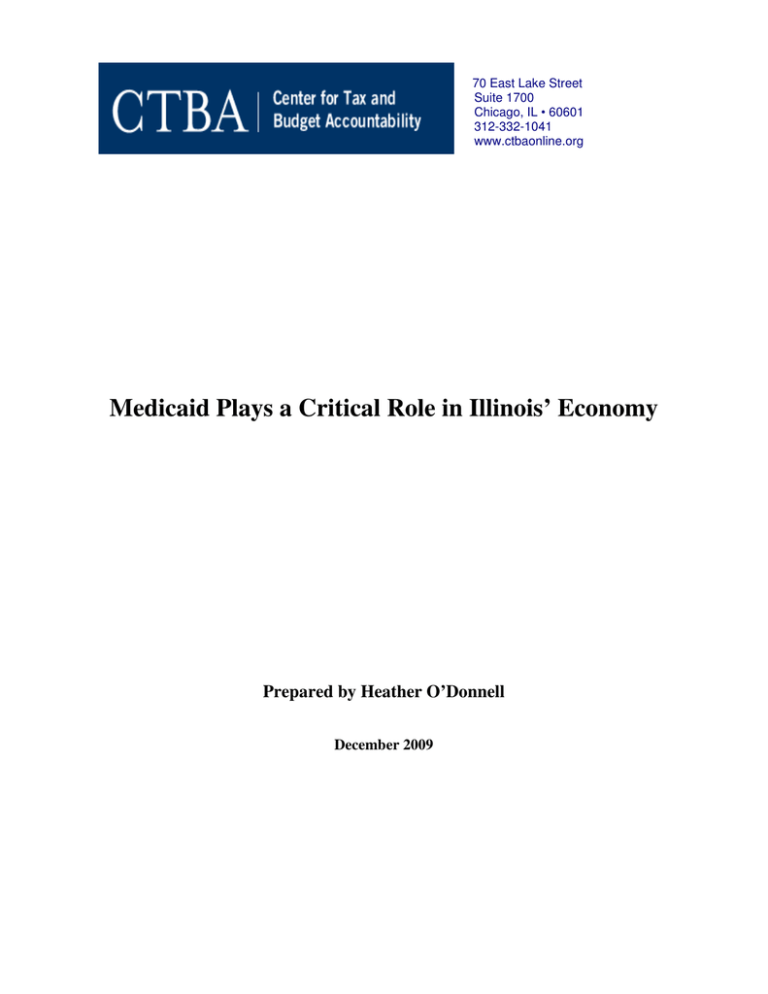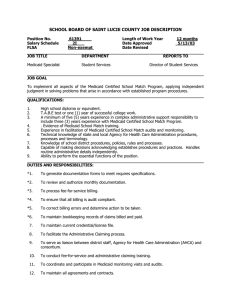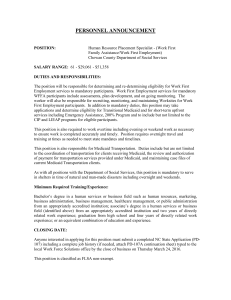Medicaid Plays a Critical Role in Illinois’ Economy December 2009
advertisement

70 East Lake Street Suite 1700 Chicago, IL • 60601 312-332-1041 www.ctbaonline.org Medicaid Plays a Critical Role in Illinois’ Economy Prepared by Heather O’Donnell December 2009 70 East Lake Street Suite 1700 Chicago, IL • 60601 312-332-1041 www.ctbaonline.org Medicaid Plays a Critical Role in Illinois’ Economy __________________________________________________________________________________________ I. Introduction Medicaid spending is often misunderstood and misrepresented because of the complexities of its financing structure. This report is intended to: (1) clarify how Illinois’ Medicaid program is funded, (2) highlight the benefits to the state of Medicaid’s financing structure, (3) identify the percentage of state, own-source general fund spending dedicated to the program and (4) demonstrate the economic impact Medicaid spending (or cuts) has on the state and local economy. Medicaid, including the State Children’s Health Insurance Program (SCHIP), is the bedrock of the nation’s health care safety-net, providing health coverage to over 60 million poor and low-income children, the disabled, and impoverished elderly individuals.1 Medicaid is financed jointly by the federal government and each state, and now ranks as the largest health insurance program in the country, surpassing Medicare, both in terms of enrollment and spending.2 Medicaid is particularly important for families, covering one quarter of all children across the country.3 Mirroring its importance nationally, Illinois’ Medicaid program is essential to providing access to health care to families living in poverty across the state. The state’s Medicaid program provided health care coverage to 2.6 million Illinoisans in 2008, more than half of which were children.4 Twenty percent of the state’s Medicaid enrollees are elderly, blind or disabled.5 Without Medicaid, the overwhelming majority of enrollees would be forced onto the ranks of the 45 million uninsured Americans. While the primary benefit of the Medicaid program is delivering health care to the most vulnerable members of society, Medicaid also has a significant economic dimension. First, Medicaid reimbursement plays a substantial role in the state’s economy, supporting local hospitals, clinics, doctors’ offices, nursing homes, community health centers and pharmacies that render services to program beneficiaries. In fiscal year 2008, an estimated $13.9 billion flowed to health care providers through the Medicaid program, paying for 50 percent of the state’s births, 25 percent of nursing home care and 16 percent of all hospital admissions.6 Medicaid accounted for approximately 15.9 percent of all health care expenditures in Illinois during 2008.7 Indeed, cuts to Illinois’ Medicaid program would result in an increase in the number of poor and low-income uninsured individuals and families, and would have a devastating impact on the state’s economy. Second, the long-standing trend of soaring health care costs has made it increasingly difficult for families to afford private health insurance. Between 1999 and 2008, the cumulative cost growth in average premiums for private family health coverage increased 119 percent.8 This is more than four times cumulative inflation and more than three times cumulative wage growth over the same period.9 For this reason, public health care programs like Medicaid have become increasingly important in ensuring access to basic health care when families can no longer afford private insurance. As millions of American workers lose their jobs and their employer-provided health insurance during the current recession, Medicaid has filled in a portion of the gap. Third, state governments, like families and businesses, are also grappling with increasing health care costs. The combination of climbing health care costs, severe fiscal constraints and increasing demand for public services like Medicaid has created the perfect storm for many states with chronic budget shortfalls. Illinois’ budget deficit for fiscal year 2011 is estimated to exceed $12 billion, primarily due to structural imbalances in the state’s revenue system.10 Even in good economic times, Illinois’ revenue growth falls far short of keeping pace with inflation.11 For this reason, the state has widening budget deficits year after year. The state’s ongoing deficits have been exacerbated by the recession as revenue shrinks further. All this at a time when Medicaid enrollment, and therefore public spending needs, are going up. That said, maintaining Illinois’ Medicaid program is critical to ensuring access to basic health care for struggling families and to stimulating the state’s economy. II. Executive Summary State and federal Medicaid spending has a positive ripple effect throughout the state and local economy. The economic impact begins with the reimbursement of direct providers for services delivered, but does not end there. As Medicaid dollars funnel through the local economy, they support wages, employment, business income, consumer spending, state tax revenue and overall economic output. In essence, Medicaid reimbursement to providers becomes, in part, the earnings of doctors, nurses, technicians, pharmacists and other staff, as well as local businesses throughout the medical industry. These earnings are then used to support mortgage payments, household and business expenses, and the purchases of goods and services in the local economies across Illinois. Medicaid’s “multiplier effect,” as economists call it, is enhanced at the state level by the program’s financing structure. Federal matching funds are dollars injected into the local economy that would not come into the state but for state Medicaid spending. Prior to the recent federal stimulus package, the cost of Illinois’ Medicaid program was shared approximately equally between the federal government and Illinois, as prescribed under the Social Security Act.12 To assist states in maintaining their Medicaid programs through the recession, the federal government included an increase in the federal Medicaid matching rate in the American Recovery and Reinvestment Act (ARRA).13 The federal contribution to Illinois’ Medicaid program increased from 50 percent of most Medicaid expenditures, to 61.88 percent.14 This increased federal participation, which began in October 2008 and extends through December 2010, significantly alleviates the amount Illinois must spend from state tax revenue to preserve the state’s Medicaid program. Using multipliers developed by Families USA that reflect the increased federal matching rate under ARRA, Illinois’ investment in Medicaid (from both state dollars and federal matching funds) resulted in an estimated $46 billion in increased business activity in 2009. The estimated value of the wages generated through the multiplier effect was $15.8 billion, supporting approximately 385,742 jobs. If state Medicaid spending is cut, Illinois will lose federal matching dollars. With the higher matching rate under ARRA, if the state cuts state Medicaid spending by $10 million, it will lose an estimated $16.2 million in federal matching funds, resulting in a net cut to Illinois’ Medicaid program of approximately $26.2 million. This is estimated to result in a loss of more than $80.4 million in business activity and $27.6 million in wages across the state. Accordingly, job loss would be certain if Medicaid is cut, worsening the recession in Illinois when the state unemployment rate has hit 11 percent, up from 6.8 percent in October 2008.15 If Medicaid is cut after the temporary increase in the federal Medicaid matching rate under ARRA ends (December 2010), the state still stands to lose $10 million in federal matching funds for every $10 million reduction in state Medicaid spending. This means total program cuts of $20 million to save $10 million in state dollars. The positive economic impact of Medicaid spending on the state’s economy is mitigated somewhat by Illinois’ chronic payment delays to Medicaid providers. Because of the state’s severe annual budget 2 deficits, it has resorted to holding back Medicaid vendor payments for months after services have been delivered. This puts an enormous financial strain on private sector health care providers that serve Medicaid patients, sometimes forcing them to borrow to cover their own business costs while waiting for reimbursement. The state’s unpaid Medicaid bills totaled $2.1 billion at the end of fiscal year 2008.16 Medicaid’s financing structure also allows the state to partner with local governments and providers to trigger federal matching funds.17 Pursuant to these partnerships, public and private health care providers make substantial financial contributions to Illinois’ Medicaid program. In fiscal year 2008, the state spent an estimated $13.9 billion on Medicaid.18 However, state general fund spending accounted for only one-third ($4.4 billion) of total spending.19 Federal matching funds of $6.6 billion and contributions from local governments and providers ($2.9 billion) accounted for fully two-thirds of total Medicaid spending in 2008.20 The ability of the state to trigger federal dollars with state, local and private provider contributions allows Illinois to fund health care for many more people than it would be able to do alone. Cuts in Illinois’ Medicaid program would push thousands of impoverished people into the ranks of the uninsured, leaving them without access to health care. As a result, hospital and other providers around the state would be forced to bear the cost of providing additional charity and uncompensated care to the newly uninsured. In addition, reductions in Medicaid would reduce the flow of dollars to health care providers, reducing employment, family and business income, state tax revenue and general economic output. Cuts in Medicaid Will Result in Losses in Business Activity and Jobs in Illinois $0.0 -$20.0 A $10M Cut in State Funds Results in Loss of $16.2M in Federal Matching Funds A $20 Million Cut in State Funds Results in Loss of $32.4M in Federal Matching Funds -$27.6M -$40.0 (millions) -$60.0 -$55.2M -$80.0 -$80.4M -$100.0 -$120.0 -$140.0 -$160.0 -$160.8M -$180.0 Loss in Business Activity Data Source: Families USA, using federal and state multipliers 3 Loss in Wages 1 Congressional Budget Office, “Fact Sheet for CBO’s March 2008 Baseline: Medicaid,” March 11, 2008. Congressional Budget Office, “The Long-Term Outlook for Medicare, Medicaid, and Total Health Care Spending,” June 2009. 3 The Kaiser Commission on Medicaid and the Uninsured, “Medicaid: A Primer,” 2009. 4 Illinois Department of Healthcare and Family Services, (Medicaid enrollment data), The Kaiser Family Foundation, State Health Facts. When referring to Illinois’ Medicaid program, all Medical Assistance programs eligible for federal matching funds pursuant to the Social Security Act are included. 5 The Kaiser Family Foundation, State Health Facts. 6 National Association of State Budget Officers, “2007 State Expenditure Report,” December 2008 (2008 Medicaid spending estimate); The Kaiser Family Foundation, (data on Illinois health care and Medicaid expenditures). 7 Center for Medicare and Medicaid Services (state health care expenditure data inflation adjusted to 2008). 8 The Kaiser Family Foundation and Health Research & Educational Trust, “Employer Health Benefits 2008 Survey,” September 2008. 9 The Kaiser Family Foundation, “Trends in Health Care Costs and Spending,” March 2009. 10 Center for Tax and Budget Accountability, “Citizen’s Guide to the Illinois Budget and Tax System,” January 2008. 11 Id. 12 42 USC §1396d(b). 13 H.R. 1. 14 Families USA, http://www.familiesusa.org/assets/pdfs/how-much-does-my-state-get-09-10_fmap_may-7.pdf. 15 Illinois Department of Employment Security, Unemployment rate, October 2009. 16 Illinois State Comptroller, Section 25 Deferred Liabilities. 17 42 USC §1396a. 18 National Association of State Budget Officers, “2007 State Expenditure Report” (2008 Medicaid spending estimate). 19 Id. 20 Id. 2 4







